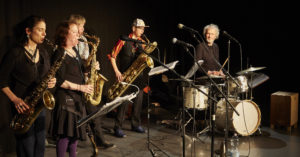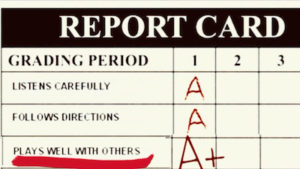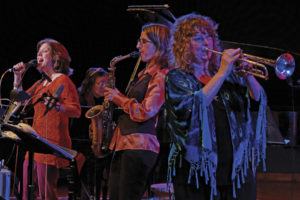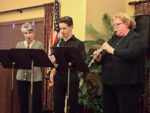Saxophone & Clarinet Lessons 503.888.5796
Plays Well With Others

 “Plays Well With Others” applies to more than your behavior in Kindergarten. How about in a musical ensemble?
“Plays Well With Others” applies to more than your behavior in Kindergarten. How about in a musical ensemble?
Can you hear the other parts as well as your own?
What is your volume level? Just because the music indicates fortissimo doesn’t mean you have to play fortissimo. If the lead player has a softer forte than you, you must play under her volume level.
Are you reading ahead to prepare for tempo changes or key changes?
Read ahead in your music just as you do when you are reading a page in a book. Instead of reading each word one at a time, whether out loud or in your head, most readers take in a whole phrase at once and are also looking ahead. Isn’t it amazing what our brains can do?!
Make the same habit in your music. When you are reading/playing music in a small ensemble, read each phrase at once. Look ahead especially when you are coming to the end of a line of music. While you’re playing the last measure in a line, look ahead to the next measure on the next line.
What is the style of the piece you’re playing?
Some of the style markings you might see on an ensemble piece of music are Latin, Rock, Swing, Mysterioso, March, Dolce, and others. Everyone in the ensemble needs to agree on how we will interpret the style marking.
How does style impact your choice of articulation?
Rock style music will have a heavy back beat – emphasis on 2 and 4. “But so does Swing,” you say. The first style plays even eighth notes and the latter style calls for ‘quarter-eighth triplet’ feel or uneven eighth notes.
Other bits of articulation you should think about are how heavy to play the accents and how short to play the staccato notes.
Are you familiar with other performances of this work?

Listening to other performances of the piece you are playing is helpful when you want to create your own interpretation of a small ensemble work.
Many pieces of music have been around a long time and are played in a variety of instrumentations, styles, and arrangements.
Sam Stept wrote the jazz tune Comes Love in 1939. Billie Holiday recorded it in a laid back swing style. I first heard it in a big band setting with a 5-piece vocal group, Gordon Goodwin’s Big Phat Band with Brian McKnight and Take 6. They performed this tune in a straight eighth Latin feel.
And just last night, I heard it performed by a Klezmer quartet (drums, accordion, clarinet, trumpet) and a vocalist in a Klezmer Jazz style. Isle of Klezbos is a New York based all-women Klezmer group. I can’t find a recording of their rendition of Comes Love. You’ll have to catch them live!
Go to the Head of The Class
As I’ve discussed in this article, playing in a small ensemble – or playing well with others – means
- listening to the other players
- being able to hear the other players
- agreeing on style and articulation interpretation
- listening to a variety of performances of the song
Do You Want To Learn More About Playing Well With Others?
This summer you have two more opportunities to join SERI, Small Ensemble Reading Intensive. We’re going to spend two hours a day together from Monday to Friday and play ensemble music – duets, trios and quartets.
Register for SERI
I’ve pulled together some fun delicious music for us to read. During the workshop (playshop?), I’ll coach you in listening to yourself and others, blending your sounds, and playing in tune. You can register here and read more about the weeklong SERI.




